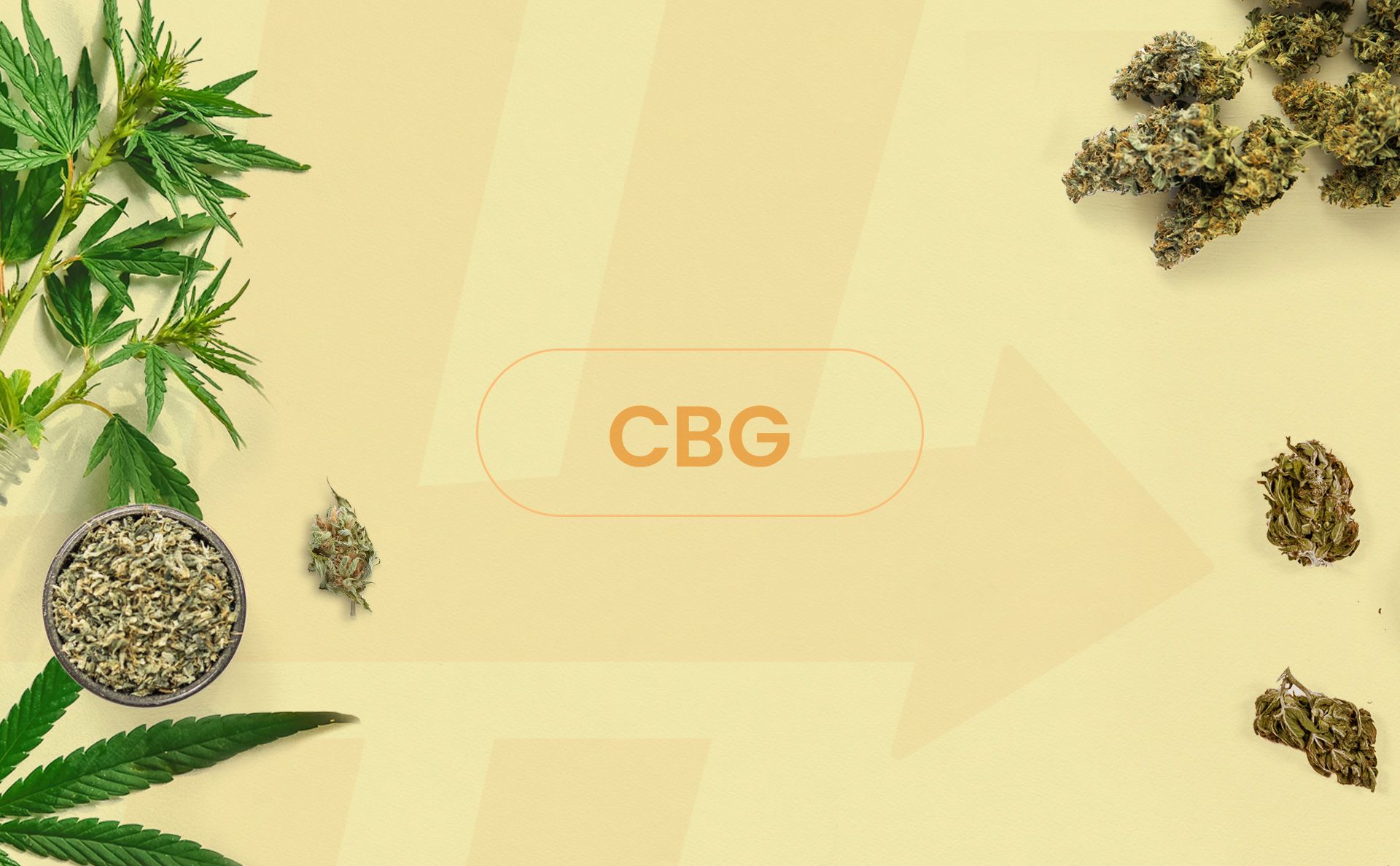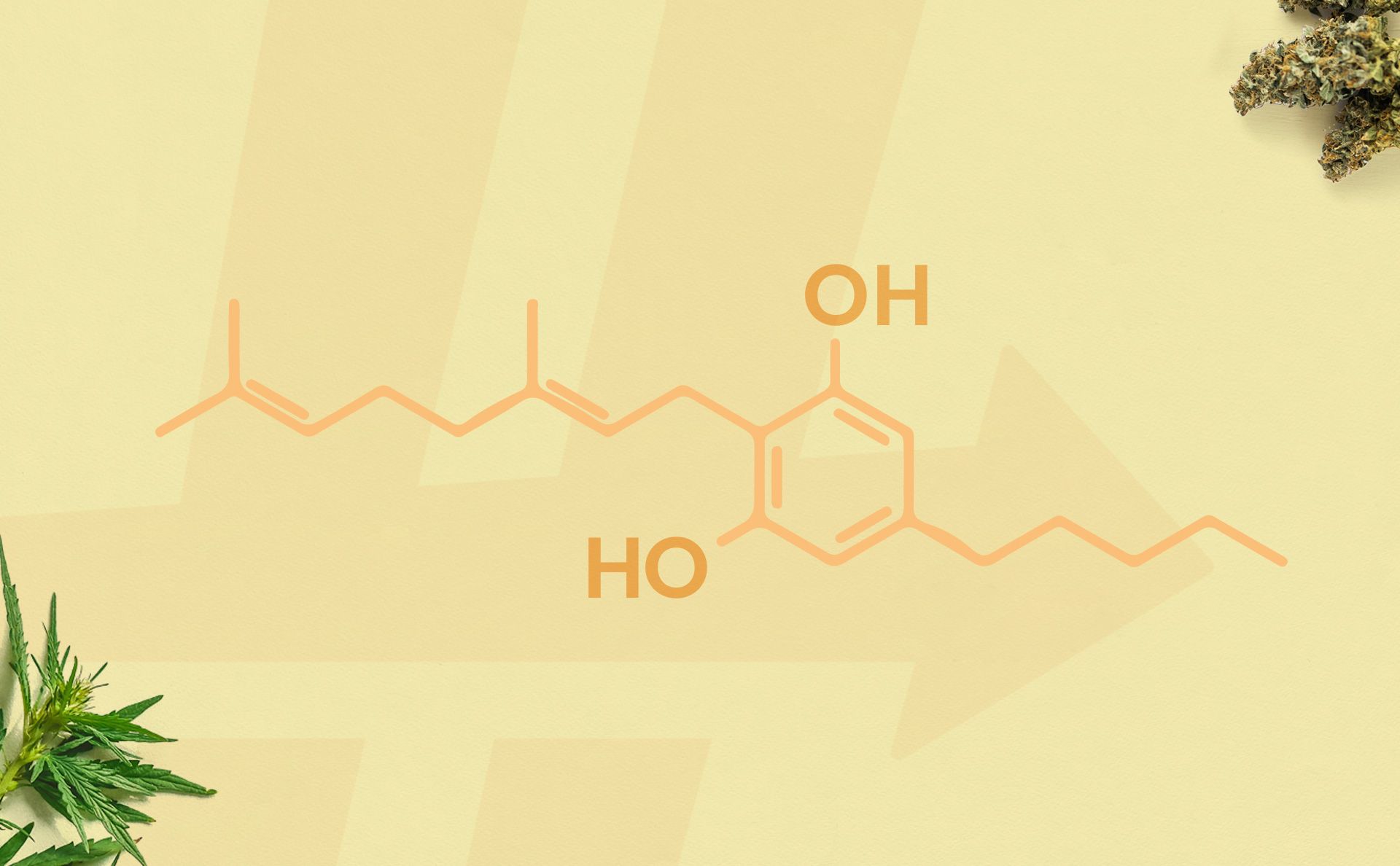CBG
CBG is another “big four” cannabinoid to cover in our “Cannabinoids Guide”. Here, we explain what CBG is, its effects, and potential benefits.

What is CBG?
Cannabigerol, abbreviated as CBG, is a major cannabinoid found in relatively smaller amounts than its cousins THC and CBD. Much like its cousin CBD, CBG has many potential therapeutic properties without the effects of feeling high like with THC. We will dive into those specific effects down below.
Currently, most CBG products are derived from legally grown hemp plants. CBG products commonly include sublingual oils, gummies, topicals, and so on to suit consumer preferences and needs. This legality is thanks to the passing of the 2018 Farm Bill, and along with it came an increased interest in other cannabinoids like CBG, and their potential benefits.
The amount of CBG you find in a cultivar depends on the cannabis chemotype. The prime example is type IV cannabis plants, which are defined by CBGA and CBG dominance.
Nowadays, type IV cannabis can be selectively bred to be up to 100% CBGA dominant. Type IV plants are also considered legal hemp because of its trace THC content, less than 0.3% by dry weight. However, you’re not likely to find this type of cannabis in dispensaries, which mainly carry type I products.

The other Cannabis chemotypes have far less CBG. Most will produce around or just over 1% CBG. This is because Cannabis plants choose early on which acidic cannabinoids they’ll favor and make more than the others (e.g., THCA-dominant in type 1, equal THCA and CBDA in type II, CBDA-dominant in type III, and CBGA-dominant in type IV).
Effects of CBG
Like the better-known and more abundant cannabinoid CBD, CBG is considered non-impairing. Unlike the famously intoxicating THC, CBG will not make most consumers feel high. That is, presuming your CBG product is of high-quality and not contaminated with excess THC.
While CBG doesn’t carry negative cognitive impacts, all the other self-reported side effects of CBG are actually similar to THC. These may include:
- Sleepiness
- Dry mouth and eyes
- Increased appetite
- Dizziness or lightheadedness

What the expert says...
Dr. Abraham Benavides
"CBG content is just around 1 percent in most cultivars, unless specifically bred for and extracted into other products. However, legal hemp thrust CBG into the retail market, and many people self-report superior effectiveness over traditional medications."
Potential Benefits of CBG
While THC and CBD have thousands of supportive studies – including hundreds of clinical ones – CBG is one of the least clinically-studied cannabinoids. Early studies on CBG indicate that it has promising pain-relieving, neuroprotective, anti-inflammatory, and anticancer properties.
Practically speaking, there’s only one clinical study on CBG in the form of a survey of 127 participants. This first-of-its-kind CBG study by Dr. Russo and team demonstrates how real-world people are effectively self-medicating using CBG for a wide range of conditions. The most common reasons people use it for include:
- Anxiety
- Chronic Pain
- Depression
- Insomnia and disturbed sleep
- Migraines and headaches
- And much more
Interestingly, the majority reported their conditions as “very much improved” or “much improved” by CBG. The vast majority also reported superiority of CBG over conventional medications including opioids, pain-relievers, antidepressants, and anti-anxiety drugs.
According to this survey, CBG may also be effective for cancer patients seeking natural alternatives to help with managing their chemotherapy side effects such as nausea, vomiting, and low appetite. It may also help ease digestive pains in patients with Crohn's Disease.
What We Learned: CBG
CBG products tend to be more expensive and rare than CBD and THC, but their availability overall is rapidly increasing. This makes research on major cannabinoids like CBG even more necessary, as the research catches up with retail use.
As is the case with so many other things cannabis-related, more clinical studies are essential to unlock the true potential of cannabinoids like CBG. Here’s what we learned about CBG:
- Cannabigerol, abbreviated as CBG, is another major cannabinoid, but found in smaller amounts than its relatives THC and CBD.
- Large quantities of CBGA and CBG can be obtained from type 4 cannabis plants, which are also considered legal hemp and may thus be harvested for retail
- In most cultivars, the amount of CBG is usually just north of one percent. However, CBG can be selectively bred up to 100% and is important to learn about.
- CBG is non-intoxicating, so it does not get you high.
- Studies on hemp-derived CBG have indicated that this minor cannabinoid may have pain-relieving, antidepressant, antianxiety, appetite-stimulating, and sleep-promoting properties.
- Despite the lack of robust clinical research, CBG is already used today by thousands of people, several of whom report “very much improved” or “much improved” symptomatic efficacy over traditional medications including opioids, NSAIDs, antidepressants, antianxiety meds, and more.
Thankfully, we will see these scientific advancements occur as more legalization happens in states, hopefully at the federal level. The advancement and evolution of the cannabis industry and cannabinoid research is barely scratching the proverbial surface.
Answer the question below and keep diving deeper into the wonderful world of cannabinoids.
Citations
- Calapai, F., Cardia, L., Esposito, E., Ammendolia, I., Mondello, C., Lo Giudice, R., Gangemi, S., Calapai, G., & Mannucci, C. (2022). Pharmacological Aspects and Biological Effects of Cannabigerol and Its Synthetic Derivatives. Evidence-Based Complementarhttps://doi.org/10.1155/2022/3336516
- Nachnani, R., Raup-Konsavage, W. M., & Vrana, K. E. (2021). The Pharmacological Case for Cannabigerol. Journal of Pharmacology and Experimental Therapeutics, 376(2), 204–212.https://doi.org/10.1124/jpet.120.000340
- Russo, E. B., Cuttler, C., Cooper, Z. D., Stueber, A., Whiteley, V. L., & Sexton, M. (2022). Survey of Patients Employing Cannabigerol-Predominant Cannabis Preparations: Perceived Medical Effects, Adverse Events, and Withdrawal Symptoms. Https://Home.Liebhttps://doi.org/10.1089/can.2021.0058
- Siracusa, L., Ruberto, G., & Cristino, L. (2023). Recent Research on Cannabis sativa L.: Phytochemistry, New Matrices, Cultivation Techniques, and Recent Updates on Its Brain-Related Effects (2018–2023). Molecules, 28(8), 3387.https://doi.org/10.3390/molecules28083387
- Smith, C. J., Vergara, D., Keegan, B., & Jikomes, N. (2021). The Phytochemical Diversity of Commercial Cannabis in the United States (p. 2021.07.05.451212). bioRxiv.https://doi.org/10.1101/2021.07.05.451212
- The Origin and Biomedical Relevance of Cannabigerol—PMC. (2022). Retrieved June 21, 2024, fromhttps://www.ncbi.nlm.nih.gov/pmc/articles/PMC9322760/
- Walsh, K. B., McKinney, A. E., & Holmes, A. E. (2021). Minor Cannabinoids: Biosynthesis, Molecular Pharmacology and Potential Therapeutic Uses. Frontiers in Pharmacology, 12, 777804.https://doi.org/10.3389/fphar.2021.777804
Test your knowledge, track your progress and earn your badge.
What are the potential benefits of CBG?

Dr. Abraham Benavides
Dr. Abraham Benavides is an internationally-recognized cannabis research expert, experienced medical advisor, and full-tuition merit scholar of the George Washington University School of Medicine and Health Sciences. Dr. Abe enjoys helping patients as a writer, educator, and cannabis health coach at the GW Center for Integrative Medicine.